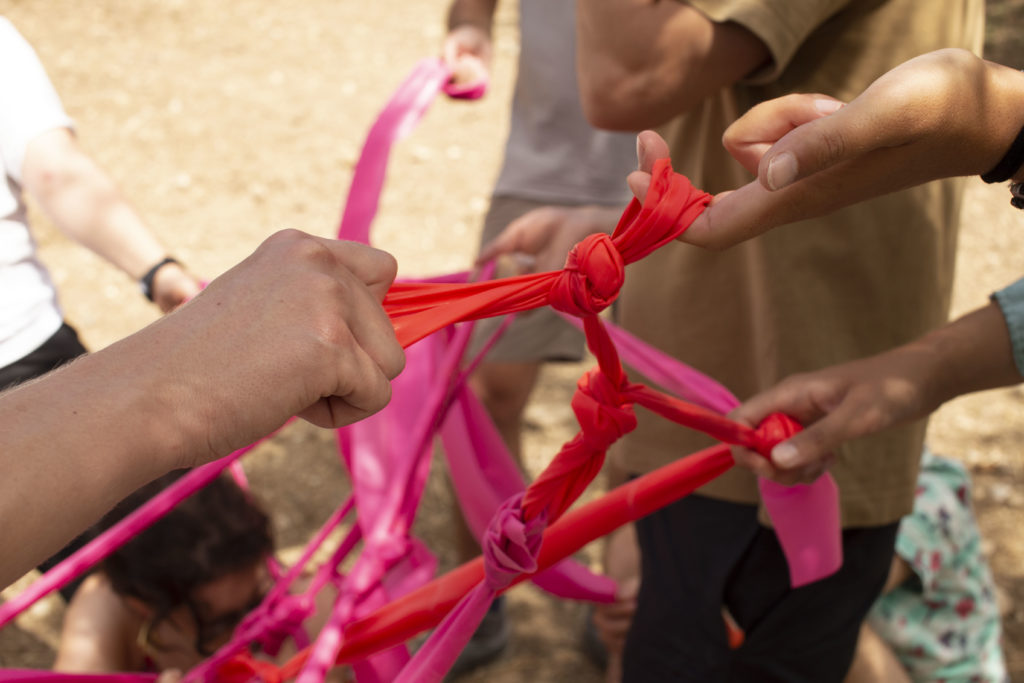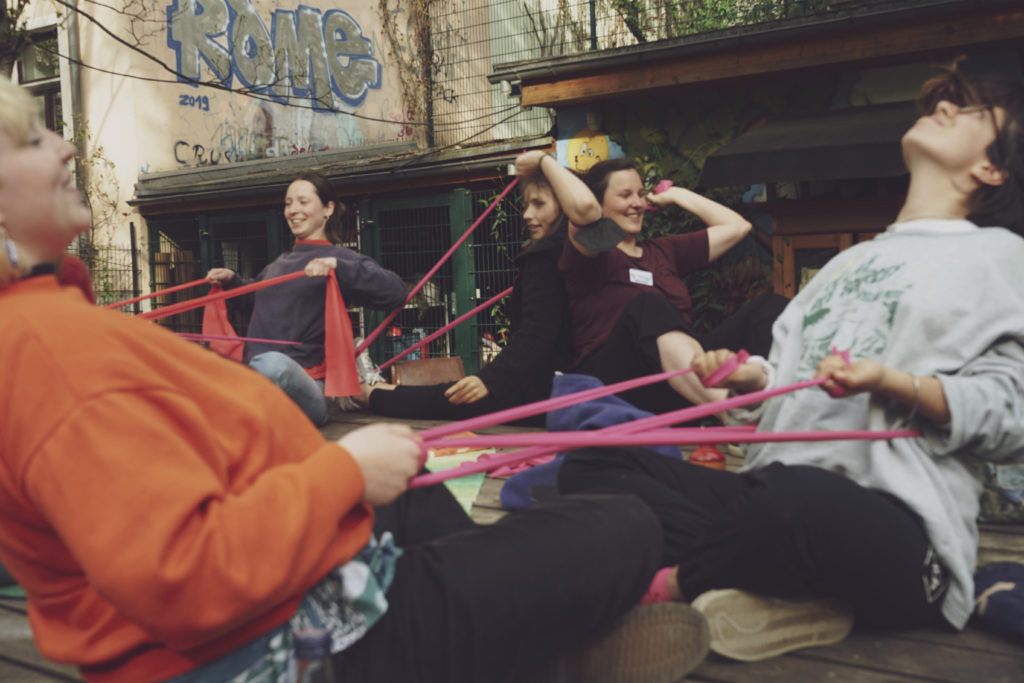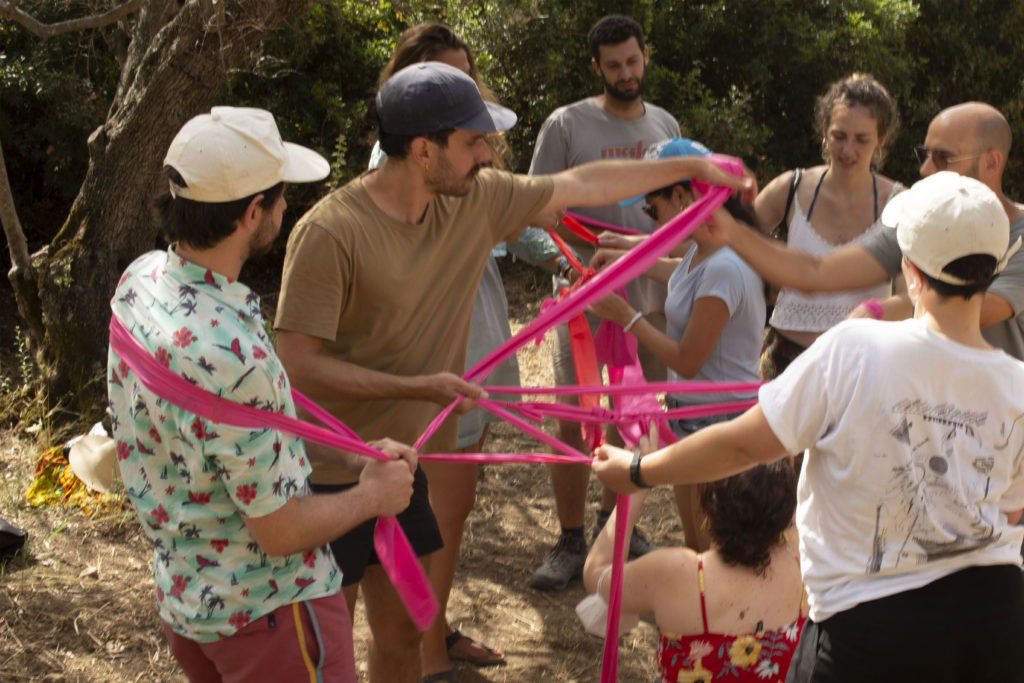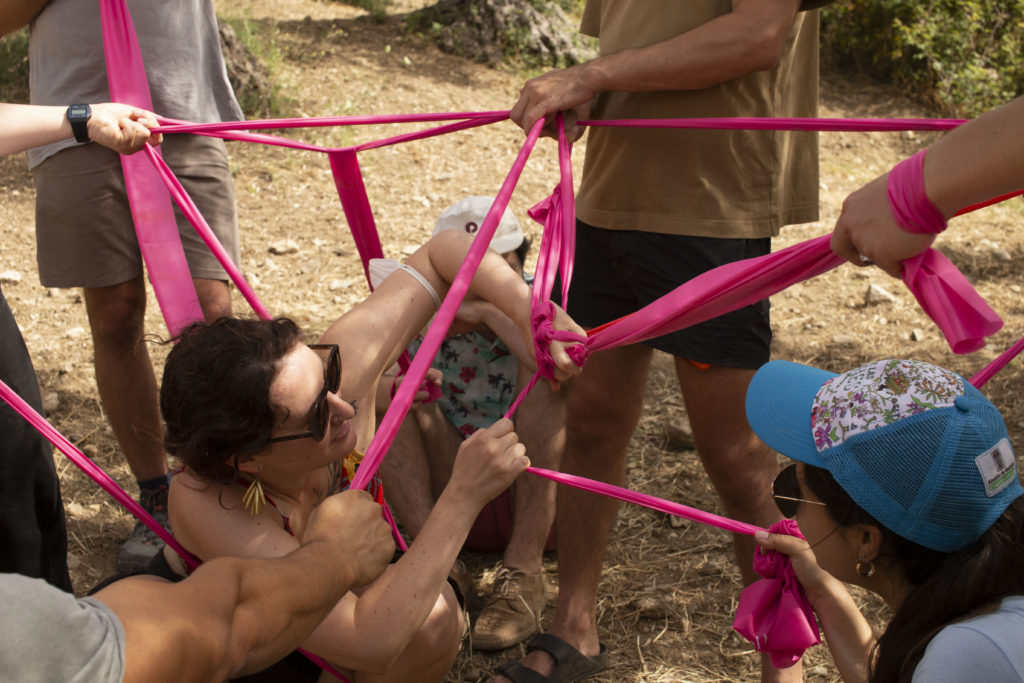Power Elastics – on queer use and feralizing space
Do you want to try embodied mapping and research injustice and the power relations of your current socio-spatial situation, or even feralize them?
Power Elastics is a critical spatial practice (cf. Rendell 2) to analyze the status quo of socio-spatial interacting networks. It can be used to interdependently critique and research power dynamics as well as engage in a shared speculative narration to create other futures. This is a potential protocol and an invitation to encounter, to practice and to share Power Elastics.
To practice Power Elastics, form a group of 8 to 20 people. While Power Elastics works very well outside, it can also be practiced inside and would then require 30 sqm of space or more. The needed working material is therapy tape (Thera Band), a gymnastic or resistance band made of latex.

Power Elastics – on queer use and feralizing space, Critical Spatial Practice by Lena Wegmann, Photo: Jannis Schiefer
Disclaimer: Power Elastics is a practice that brings bodies and minds into collective movement and vibration, it is not a form of exercise. Power Elastics does not require a sporty, abled or heteronormative cis body, rather it invites different bodies to engage in a shared experience of interdependence.
A POTENTIAL PROTOCOL OF POWER ELASTICS
0. On spatial well-being
Engaging in critical spatial practice means first finding a comfy place and settling down temporarily. Introduce yourself to one another, share names, pronouns and more if you want. But in order to have a safer space, no one has to actually say anything. Everyone has the right to be slow, silent, non-verbal and/or non-participatory. As a way to start active listening and to softly activate the bodies, share Lola Olufemi’s note on design.
~ to be read aloud ~
A note on design:
‘I would wish us to indicate the determining relationship between architectonic reality and physical well-being. I hope that we may implicitly instruct the reader in the comprehensive impact of every Where, of any place. […].’ – June Jordan
We don’t think that the layout of a house or street can determine our capacity for being. Living as we do, on top of one another, with no room to stretch our legs or for our children to play, and being isolated, not knowing our next-door neighbours, not knowing whom we could depend on in an emergency, is a political question.
[…] June Jordan knew this; if you changed how People conceived of living, you could also change their understanding of themselves and their relations with others, breaking the inertia of this unlivable life.
The way we talk about this life and living, the language we use, builds a kind of structure that turns the horizon (that point where potentiality meets the substance of our reality) into a mirage.” (Olufemi: 42-43)
1. On flexible bodies
The practice of Power Elastics relates to you, the participating people, the setting and the chosen topic/case study for the session. Come together in a circle to share how and what you need to participate, support and feel safe during the practice; this is supposed to happen before the embodied practice begins. In between and during the practice, there should be breaks possible whenever necessary. If you don’t know each other, it can be helpful to slow down. If the vibes are energetic, there should be space to be active with one’s body in the warm-up.
In the warm-up, play catch with therapy tape, explore the material and its possible interaction with your own body in joyful solitude (support provided, if requested). To activate the elastic material, slow or energetic exercises, moves and gestures without order can be performed at one’s own tempo.
After a while, the round is closed by all getting together and sharing the experience. Helpful questions could be: How did it feel? How would you describe the material? Do you experience more pressure, tension or power? What does your body want to share with us? What do you need to get in contact with in order for others to feel safe and have support?

Bodies enjoy their flexibility, Symposium feminist geographies Berlin 2022, Photo: Ann Roy
In the next round, form groups of two or three people to warm up together. In an emerging process of trust building, you are scaffolding for more complex figures. You can bring each other into stretches or relax by providing flexible support. To share this flexibility with others, the group could discuss the following questions: How did it feel? What does your body or what do your bodies want to share with us? What differences have you experienced in relation to each other? Which kind of gestures, movements and/or exercises did you enjoy? Which did you not?
2. On gestures and queer use
While the straight and hegemonic present determines our lives and acts as a gatekeeper, there does exist queer embodied practices to refuse and to connect to each other. In the warmed atmosphere, the approaches by Sara Ahmed and José Esteban Muñoz are shared to situate the critical spatial practice and offer discursive input for the following experience.
~ to be read aloud ~
“Dance is an especially valuable site for ruminations on queerness and gesture. […][M]en and women [and non-binary people] who share a global sphere of queer knowing, moving, and feeling. At the center of that international sphere of queer experience are gesture, [Kevin] Aviance’s resonant poses, and the force of queer epherma.[…] [T]he dance floor increases our tolerance for embodied practices.” (Muñoz: 65-66)
“In not getting used to it, bodies become expressive. The word express comes from press. It implies something that is squeezed out. […] A queer use of the body allows bodies to do the talking. I think too of snapping fingers as part of this signaling of a refusal to get used to something. Marlon Riggs explores finger snapping as an expression of political resistance perhaps akin to the clenched fist for African American gay man. […] Finger snapping can say: don’t mess with us. Finger snapping offers a way of speaking back and speaking to, a language of the body that gives room to be in a body that is not given room.” (Ahmed: 228)
~ snap your fingers, if you feel like it ~
3. On elastic mapping
Following this, you will map together your social-spatial situation using your bodies as positions and the therapy tape as a connecting device. Your social-spatial situation can be the environment you are currently in, but you do not have to be in the space itself to map your neighborhood, your socio-spatial interacting network, or a case study you are working on. It can be an imagined situation. It is possible to start with spatial landmarks (streets, houses, libraries, etc.) to make an initial fast mapping of the spatial relations and to understand the method. But the main purpose of Power Elastics as a collective mapping tool is to analyze socio-spatial situations with the associated actors and their powerful entanglements.
To reflect on the socio-spatial relations that produce space, choose socio-spatial positions or actors with agency in your case study. This can be all possible actors involved in the case (you can identify with them, but there is no need) from mayor to developer, from housewife to facilitator, from fox to tree.
The map grows by defining each other with or without therapy tape connections. To negotiate the positions and explore interdependence, the group can get oriented with these questions: Do we have a physical, social or spatial connection? Are the positions nearby or far away? Start with two or three positions and arrange the others in relation. Move in space and use distance as well as closeness. Is an important position missing? If yes, maybe one or two positions are able to switch and fill the gaps or the group can agree that the map will never be fully complete.
When mapping has manifested, everyone names their chosen position and how it feels to be in this position. Eventually they may be under a lot of pressure, feel disconnected or have difficulty maintaining the many connections.

Feeling interdependence while elastic mapping, Simeri Laboratorio Urbano Italy 2021, Photo: Jannis Schiefer
To become a more precise embodied map, positions with more societal power and/or capital or commodification (process of becoming a commodity) are supposed to stand up fully. Positions with less power and/or capital can move to a lower position e.g., sit, squat or move your hands and body parts holding the therapy tape connection(s) towards the floor. Powerful positions can also increase the pressure on the connections.
While holding the embodied mapping in place, you open up to each other and share your physical perceptions and feelings that emerge. To create discourse around the powerful relations, you may use the following approaches: How do you experience spatial and social distance? What are the underlying feelings of these connections? How does it feel to be in the chosen position? Which tensions are coming up? Which connections have not been clear before? Are there actors who feel disconnected or under enormous pressure? How does the embodied complexity of the case study or situation feel for the group? What are the inter-relations of these power dynamics or their power to imprison positions in their bind?
4. On wildness
Powerful entanglements make people tired or give them the feeling of being unable to act. They maintain and reproduce the social order. As an antithesis to social order, our vocabulary offers up the wild and the wild is risky. It can be linked to naturalization, essentialization, discrimination, racism, romanticization and slurs to reproduce and sustain these same existing power relations. Jack Halberstam reminds us,
“Wildness cannot speak without producing both the colonial order that gives it meaning and the disruption of that order through temporal and spatial and bodily excess and eccentricity. […] Queerness without wildness is just white homosexual desire out of the closet and in sync with a new normal.” (Halberstam: 39)
How would such a wildness, a queer wildness beyond these powerful attributions be felt and sensed? How would we experience it and what would we call it?
~ to be read aloud ~
“Moten and Harney want to gesture to another place, a wild place that is not simply the left over space that limns real and regulated zones of polite society; rather, it is a wild place that continuously produces its own unregulated wildness.”(Halberstam, in Moten and Harney: 7)
“In the terrain of the ferox, bodies flee, escape, hide, and seek. […] The desire to revert to a feral state […] reaches for a world beyond human, for relations to other animal forms of life, to emotional genres that exceed the cycles of wanting, needing, guilt, and regret that characterize human domesticity.” (Halberstam: 110)
“Queerness, Muñoz’s legacy instructs us, is what keeps the horizon at bay and what runs to greet it. And wildness manages the space between here and now, then and there, and names what comes after nature, after queerness and before the worlds they have dreamed.” (Halberstam: 49)
“To think multitudinously is to think in excess of the singular and the abject because a multitude’s many-ness offers possibility. […] The multitude does not abide implicit coherences and discrete categorization, nor does it abide binaristic thinking that disallows the in-between or the outside (e.g., the nonbinary). […]In black trans resilience, an embodied ‘antagonism of subjectivity,’ as jayy dodd calls it, there is flexibility. […] Being and becoming trans ‘means to be elastic,’ undoing and redoing one’s subjectivity […] [.]” (Bey: 214)
~ snap your fingers, if you feel like it ~
5. On feral relations
To feralize would eventually make a speculative connection to the times and spaces we dream of or miss, that release us in the future, or retell our empowering past. The feral state of being in-between opens the way for relationships, multitudes and elastic situations beyond. How can we open up to feralize our relations? What kind of relations would grow?

Feralizing Power and deep meaningful relations, Simeri Laboratorio Urbano Italy 2021, Photo: Jannis Schiefer
Subsequently, these jointly mapped power structures are tested for their feral mutability and set into queer vibrations. With Jack Halberstam’s words:
“Or can this wildness instruct us in new ways of listening, different forms of knowing, and alternative logics of embodiment, aesthetic expression, desire, history, and beauty?” (Halberstam: 52)
Use the questions to negotiate your positions and feralize them when you are ready. In which positions did wild feelings emerge in the previous mapping? What kinds of queer use are helpful to send feralized signal waves through connections and the elastic material? Which are meaningful or wild connections and why? How can we deepen meaningful connections? What would potentially collapse structures or connections? Which “wild” things, desires, more-than-human, animal, queer or trans practices lead to the feral?
What differences have you experienced in relation to each other? What would be a release of pressure for feral relations?
Loosen the Thera Tape bonds slowly, produce no harm and come together to calm down with one another. Power Elastics enables groups to have a common immersive understanding. The practice is determined by the case study itself, the (social) positions taken, the knowledge available, how safe the place is perceived to be, the participants and their abilities to communicate the re-enacted relationships, as well as their negotiation of the possible. The shared individual experience is evaluated collectively in discourse and the networks of relationships are socially situated. How does it feel to feralize, to be fierce, to be _______?
~
What would a queer, intersectional and feral world look like? It is “not yet” possible to say as it describes potential times and spaces (cf. Muñoz: 1; 96) and does not reflect the present situation. Current demands on the urban and the rural in the context of the climate and housing crisis, racism, transphobia, austerity policies and increasing polarization are complex and sometimes mutually reinforcing. They can be simultaneously experienced forms of discrimination, tensions, as well as interactions of socio-spatial power relations (as perhaps analysed with Power Elastics).
Instead of reproducing existing power relations, working on individual levels or even trying to create a solution that fits all (i.e. for all who have power), the interrelatedness of these demands must be recognized. Those who are elastic, who know the multitude and can withstand brokenness, can try out practices in-between the complexity. In order to co-produce in a spatially just way, critical, intersectional and queer positions are needed. Jack Halberstam offers critical potentialities for these ways of being in-between, outside or beyond:
“If the wild has anything to tell us, it is this: unbuild the world you inhabit, unmake its relentless commitment to the same, ignore the calls for more, and agree to be with the wild, accept the wild, give yourself to the wild, and float or drown in its embrace” (Halberstam: 180).
The integration of solidarity-based embodied knowledge production on the spatial dimensions of injustice and on the potentiality of empowering is necessary to feralize and to trans/figure in normative social and spatial structures. While Power Elastics embraces interdependence, it enables and empowers to speculate on other equitable structures of how space could be produced for multitudes of meaningful beings and for narrations of queer, feralized futurities.
REFERENCES
Sara Ahmed (2019): What’s the Use, On the Uses of Use, Duke University Press, Durham.
Marquis Bey (2022): Black Trans Feminism, Duke University Press, Durham.
Jack Halberstam (2020): Wild Things, the disorder of desire, Duke University Press, Durham.
Fred Moten and Stefano Harney (2013): The Undercommons, Fugitive Planning & Black Study, Minor Compositions, New York.
José Esteban Muñoz (2009): Cruising Utopia, New York University Press, New York.
Lola Olufemi (2021): Experiments in imaging otherwise, Hajar Press, London.
Jane Rendell (2008): ‘Critical Spatial Practice’, Art Incorporated, Kunstmuseet Koge Skitsesamling, Denmark.